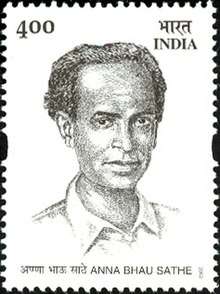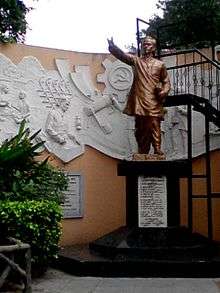Annabhau Sathe
Tukaram Bhaurao Sathe (1 August 1920 – 18 July 1969), popularly known as Annabhau Sathe, was a social reformer, folk poet, and writer from Maharashtra, India.[1] Sathe was a Dalit born into the untouchable Mang community, and his upbringing and identity were central to his writing and political activism.[2] Sathe was a Marxist-Ambedkarite mosaic, initially influenced by the communists but he later became an Ambedkarite.[3][4][5][6][7] He is credited as a founding father of 'Dalit Literature'.[8][9][10]
Tukaram Bhaurao Sathe | |
|---|---|
 Sathe on a 2002 stamp of India | |
| Born | Tukaram 1 August 1920 Wategaon sangli |
| Died | 18 July 1969 (aged 48) Mumbai |
| Nationality | Indian |
| Other names | Sahitya-samrat, Lokshahir, Annabhau |
| Occupation | social reformer |
| Known for | Novel writer, poet, film story writer |
Notable work | Samyukt Maharashtra Movement |
Early life
He was born on 1 August 1920, in Wategaon village, part of present-day Maharashtra's Sangli district, to a family that belonged to the untouchable Matang caste.[11] Members of the caste used to play traditional folk instruments in tamasha performances.
Annabhau Sathe did not study beyond class four.[12] He migrated from Satara to Bombay, present-day Mumbai, in 1931, on foot, over a period of six months, following a drought in the countryside. In Bombay, Sathe undertook a range of odd jobs.[11]
Writings
Sathe wrote 35 novels in the Marathi language. They include Fakira (1959), which is in its 19th edition and received a state government award in 1961. It is an interesting novel which tells the story of the protagonist; the stout young guy, named Fakira, his feat, his crusading for the rights of people of his community in the British regime (India) and his enmity towards the evil forces in the village. However, the cause from where the story progresses is the religious practice or ritual called 'Jogin' which gives a way to further actions. There are 15 collections of Sathe's short stories, of which a large number have been translated into many Indian and as many as 27 non-Indian languages. Besides novels and short stories, Sathe wrote a play, a travelogue on Russia, 12 screenplays, and 10 ballads in the Marathi powada style.[1]
Sathe's use of folkloric narrative styles like powada and lavani helped popularise and make his work accessible to many communities. In Fakira, Sathe portrays Fakira, the protagonist, revolting against the rural orthodox system and British Raj to save his community from utter starvation.[1] The protagonist and his community are subsequently arrested and tortured by British officers, and Fakira is eventually killed by hanging.[13]
The urban environment of Bombay significantly influenced his writings, which depict it as a dystopian milieu. Aarti Wani describes two of his songs – "Mumbai Chi Lavani" (Song of Bombay) and "Mumbai cha Girni kamgar" (Bombay's Mill-hand) – as depicting a city that is "rapacious, exploitative, unequal and unjust".[14]
Politics
Sathe was initially influenced by communist ideology.[13] Together with writers such as D. N. Gavankar and Amar Shaikh, he was a member of Lal Bawta Kalapathak (Red Flag Cultural Squad), the cultural wing of the Communist Party of India,[11] and a tamasha theatrical troupe that challenged government thinking. It had been active in the 1940s and, according to Tevia Abrams, was "the most exciting theatrical phenomenon of the 1950s" before communism in India generally fragmented in the aftermath of independence.[15] He was a significant figure also in the Indian People's Theatre Association, which was a cultural wing of the Communist Party of India,[16] and in the Samyukta Maharashtra Movement, which sought the creation of a separate Marathi-speaking state through a linguistic division of the extant Bombay State.[14]
Sathe shifted toward Dalit activism, following the teachings of B. R. Ambedkar, and used his stories to amplify the life experiences of Dalits and workers. In his inaugural speech at the first Dalit Sahitya Sammelan, a literary conference that he founded in Bombay in 1958, he said that "The earth is not balanced on the snake's head but on the strength of Dalit and working-class people," emphasising the importance of Dalit and working-class people in global structures.[13] Unlike most Dalit writers of the period, Sathe's work was influenced by Marxism rather than Buddhism.[17]
He said that "Dalit writers are entailed with the responsibility of liberating and shielding Dalits from the existing worldly and Hindu tortures as the long standing conventional beliefs cannot be destroyed instantly."[13]
Legacy


Sathe has become an icon to Dalits, and especially the Mang caste. The Lokshahir Annabhau Sathe Development Corporation was established in 1985 to further the cause of the Mang people, and women in local branches of the Manavi Hakk Abhiyan (Human Rights Campaign, a Mang-Ambedkarite body)[18] organise jayanti (processions) in his name and those of Babasaheb Ambedkar and Savitribai Phule.[19] Political parties, such as the Indian National Congress and the Bharatiya Janata Party-Shiv Sena alliance, have attempted to appropriate his image as a means of drawing electoral support from the Mangs.[20]
Sathe was commemorated with the issue of a special ₹4 postage stamp by India Post on 1 August 2002.[21] Buildings have also been named after him, including the Lokshahir Annabhau Sathe Smarak in Pune[22] and a flyover in Kurla.[23]
References
- Jamdhade, Dipak Shivaji (June 2014). "The Subaltern Writings in India: An Overview of Dalit Literature" (PDF). The Criterion. 5 (3). Retrieved 5 April 2015.
- Paul, S. K. (2007). "Dalitism: Its Growth and Evaluation". In Prasad, Amar Nath; Gaijan, M. B. (eds.). Dalit Literature: A Critical Exploration. Sarup & Sons. p. 36. ISBN 978-81-7625-817-3.
- पवार, J. V. Pawar जे वी (13 April 2019). "The history of Marathi Ambedkarite Literature". Forward Press. Retrieved 1 August 2019.
- Awad, Milind (2010). The Life and Work of Annabhau Sathe: A Marxist-Ambedkarite Mosaic. Gaur Publishers & Distributors. ISBN 9788189441111.
- "Annabhau Sathe - Forgotten Hero, Communist Who Turned To Ambedkarite". velivada.com. Retrieved 1 August 2019.
- Sahni, Bhisham (10 November 2015). Today's Pasts: A Memoir. Penguin UK. ISBN 9789385890192.
- "आजही अण्णा भाऊ." Loksatta (in Marathi). 1 August 2013. Retrieved 1 August 2019.
- "Remembering Annabhau Sathe, The Dalit Writer Who Dealt A Blow To Class and Caste Slavery". HuffPost India. 1 August 2019. Retrieved 1 August 2019.
- "Annabhau Sathe – Remembering The Founder of 'Dalit Literature'". Velivada. Retrieved 1 August 2019.
- https://epaper.loksatta.com/2260797/loksatta-mumbai/28-07-2019#page/10/2
- Bhattacharya, Aritra (1 August 2018). "Ambedkarite or Marxist? Annabhau Sathe chose to cast his lot with the oppressed". Scroll.in. Retrieved 1 August 2018.
- Maitreya, Yogesh (15 October 2017). "The sound and fury of Anna Bhau Sathe's words: An icon of Maharashtra's Dalit literature – Firstpost". Firstpost. Retrieved 1 August 2018.
- Gaikwad, B. N. (February 2013). "Manifestation of Caste and Class in Anna Bhau Sathe's Fakira and Baburao Bagul's Jenvha Mi Jaat Chorli Hoti" (PDF). The Criterion. 4 (1). Retrieved 5 April 2015.
- Wani, Aarti (2016). Fantasy of Modernity. Cambridge University Press. pp. 27–28. ISBN 978-1-10711-721-1.
- Abrams, Tevia (1993). "Tamasha". In Richmond, Farley P.; Swann, Darius L.; Zarrilli, Phillip B. (eds.). Indian Theatre: Traditions of Performance. Motilal Banarsidass. pp. 282, 288. ISBN 978-8-12080-981-9.
- Bhattacharya, Binayak (2016). "The Left Encounter: Progressive Voices of Nationalism and Indian Cinema to the 1950s". In Kishore, Vikrant; Sarwal, Amit; Patra, Parichay (eds.). Salaam Bollywood: Representations and Interpretations. Routledge. pp. 26, 38. ISBN 978-1-31723-286-5.
- Zelliot, Eleanor (1978). "Dalit: New Cultural Context for an Old Marathi Word". In Maloney, Clarence (ed.). Language and Civilization Change in South Asia. BRILL. pp. 78, 82. ISBN 978-9-00405-741-8.
- Waghmore, Suryakant (2016). "Challenging Normalised Exclusion: Humour and Hopeful Rationality in Dalit Politics". In Gorringe, Hugo; Jeffery, Roger; Waghmore, Suryakant (eds.). From the Margins to the Mainstream: Institutionalising Minorities in South Asia. SAGE Publications. p. 151. ISBN 978-9-35150-622-5.
- Waghmore, Suryakant (2013). Civility against Caste: Dalit Politics and Citizenship in Western India. SAGE Publications. pp. 34, 57, 71–72. ISBN 978-8-13211-886-2.
- Waghmore, Suryakant (2013). Civility against Caste: Dalit Politics and Citizenship in Western India. SAGE Publications. p. 152. ISBN 978-8-13211-886-2.
- "Stamps 2002". Department of Posts, Government of India. Retrieved 31 July 2017.
- "Lokshahir Annabhay Sathe Smarak". Pune Metropolitan Corporation. Retrieved 31 July 2017.
- Devnath, Shiva (25 May 2016). "Mumbai: 24-year-old woman stabbed to death in broad daylight". Mid-day. Retrieved 31 July 2017.
External links
| Wikimedia Commons has media related to Annabhau Sathe. |